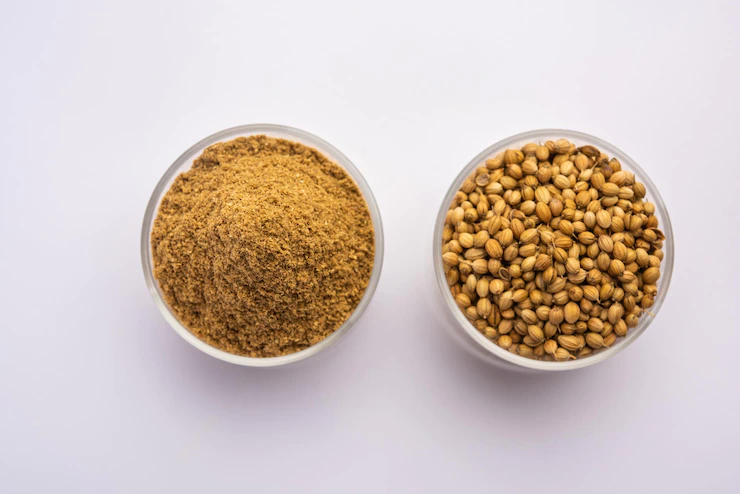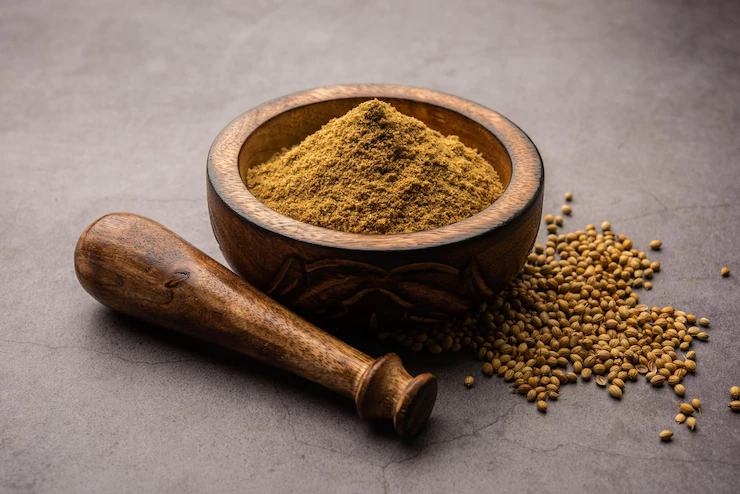Coriander powder, also known as Ground Coriander, is a must-have. This recipe for homemade coriander powder is simple to create, fresh, and less expensive than store-bought coriander powder. You may buy coriander powder in supermarkets, but handmade coriander powder adds a fresh, aromatic flavor to recipes without any additions and is also more cost-effective.
Coriander (Coriandrum sativum) is a parsley-like aromatic herb. The plant’s fresh leaves, called cilantro or Chinese parsley, have a distinct citrus flavor. In European, Asian, Latin, and Indian cuisines, the dried seeds are used whole or crushed as a spice. Coriander is native to the Mediterranean region, North Africa, and southwestern Asia. It is one of the most ancient herbs, and spices are known to man. Seeds have been unearthed in Bronze Age ruins, and the plant has been mentioned in the Bible.
What Is Coriander Powder?
Coriander powder, often known as ground coriander, is ground coriander seeds. In Hindi, it’s known as Dhaniya Powder. It can be made with or without the coriander seeds being roasted, and both give the dish a varied texture and flavor. Whole coriander seeds are typically used in spice blends, pickling spices, and spice pastes, and ground coriander is commonly used in curries, soups, and stir-fries.
Coriander seeds add the proper amount of spice when used whole, but they blend in with the meal and improve the overall flavor profile when ground. While coriander seeds can be kept for extended periods, ground coriander should be kept in small amounts. Because they quickly lose their scent, I usually make them in small amounts.
How to make Coriander Powder?
Coriander powder is made in a simple two-step method involving roasting and grinding. Let’s have a look at how it’s done. Skip stepping four if you want to ground it without roasting it.
Ingredients
- 1 cup coriander seeds
Instructions
Step 1: Roasting Coriander Seeds
For 2 minutes over medium heat, heat a heavy bottom pan on the stove. Dry roast the coriander seeds for about 5 minutes, stirring constantly, or until they become fragrant and somewhat deeper in color.
Turn off the heat and transfer the coriander seeds to a plate to stop cooking. Allow 20-30 minutes for it to cool completely.
Step 2: Grinding Coriander Seeds
Grind cooled roasted coriander seeds in a coffee or spice grinder in batches. To keep the powder from clumping, pulse it a few times while shaking the blender. Scrape the sides once in a while if necessary.
Pulse until the mixture is finely ground. Store in an airtight container for six months in a cold, dry location.
Benefits of Coriander
While coriander gives out a distinctive and refreshing aroma, it is also packed with so many benefits:
- They help in maintaining your blood glucose which in turn prevents diabetes.
- It has many nutrients like Vitamin A, Riboflavin, Vitamin C, and Folic acid.
- Helps in curing digestive problems.
- It is anti-inflammatory and cures skin problems.
- It is rich in dietary fiber and is an excellent source of minerals like Zinc, Potassium, Calcium, and many more.
What Does Coriander Taste Like?
Coriander has a vibrant, citrusy flavor and a fragrant scent. It gives any dish a distinctive burst of sweet citrus flavor. It’s a mild spice that adds flavor without being overbearing. Coriander is a very fresh-tasting spice with a floral and lemony flavor. Its moderately sweet, lemony flavor is frequently combined with other spices in savory dishes; cumin and coriander are frequently used together.
The coriander leaves should have a light, lemony flavor. Coriander seeds are the dried fruit of the plant, and they can be utilized whole or crushed. It has an earthy, acidic, and sweet flavor and a floral scent when toasted.
What Are Coriander Seeds?
The cilantro plant’s fruit or seeds are known as coriander seeds, and it’s used as a seasoning in a variety of cuisines worldwide. When the coriander plant stops developing, the seeds begin to bolt.
The coriander seed is a tiny, hard, brownish seed that is an essential ingredient in pickling spices. The perfume of coriander seed is pleasant and spicy, and in Hindi, it’s known as Dhaniya seeds.
How to Use Coriander Powder?
I usually add coriander powder and other spices like turmeric, cumin, and others during the cooking process. Even though coriander seeds and ground coriander share the same ancestor, they are very diverse and unique flavor characteristics. Coriander powder and whole coriander seeds are used in spice blends and recipes. Furthermore, if you’re asking if they may be substituted for one another, the answer is no, as their flavor profiles are entirely different.
Where to Buy Coriander Powder?
Most grocery stores have whole coriander seeds in the spice section, and they’re also available in Latin American, Indian, North African, and Middle Eastern specialty stores. Ground coriander powder is also available in the spice section of most supermarkets.
I hope you give this ground coriander powder a try and make some tasty meals with it. Whole and ground coriander can be found in the spice department of the shop. If you don’t use it frequently, buy the whole seeds and toast and ground them right before using them to get the most incredible flavor.
What Can You Substitute for Coriander?
- Seeds of fennel, cumin carry fennel, cumin, or caraway seeds life. Try fennel, cumin, or caraway seeds if you don’t have the entire corianders.
- Coriander powder. If you only have ground coriander and a recipe asks for whole seeds, replace each teaspoon of coriander seed with 34 teaspoons of ground coriander.
- Best Spices to Use: Cumin. Masala Curry Powder. Garam Masala.
- Mix These Spices: Equal parts cumin and oregano.
- Spices to Use in a Pinch: Caraway Seeds. Dried Oregano.
- Best Bet: Caraway Seeds. Caraway seeds are in the same family as coriander and will give a similar earthy, anise flavor to any dish.
Conclusion
Keep coriander away from heat and light in a cold, dark spot (like your spice cabinet). This prolongs the life of the spice. Alternatively, you can freeze whole coriander seeds. Whole coriander seeds should be utilized within a year, although ground coriander can be saved for six months if properly preserved. These two spices are similar, yet they come from different plants and have diverse flavors profiles that are smokey and bitter, but coriander is fragrant and pleasant.
When coriander seeds are dry roasted on low heat, delicate oils are generated, helping to darken the seeds and bring out the most excellent flavor. It also aids in the removal of moisture and extends the shelf life. Whole coriander seeds are widely available in Indian and Middle Eastern foods and Amazon, and grounded coriander is also available in the spice section of supermarkets.

